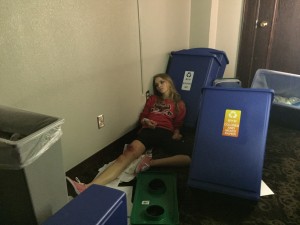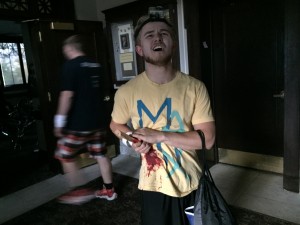
On Saturday, Oct. 17, dozens of BYU EMTs and nursing students ran into the Maeser Building, responding to a call. This was not an actual disaster, but a mock earthquake.
Every semester, certified BYU students who volunteer as emergency medical technicians and students from the nursing program host an elaborate mock mass casualty incident simulation. This semester was an earthquake. Over a hundred nursing students, EMTS and volunteers who acted as “victims” took part in the event.
Prior to the simulation, volunteers met in the HFAC where they assigned injuries they would sustain in the “earthquake,” and corresponding makeup was applied. Then, volunteers made their way to the Maeser building where they made it look like an earthquake had hit and pretended to be injured.

The simulation actually started when EMTs and nursing students were alerted of the “earthquake” and rushed to the scene. They ran into the Maeser and brought the “injured” and “dead” onto the lawn outside. Students went to different parts of the lawn to be “treated,” depending on the calamity of their injuries. Some were also brought to the nursing department’s simulation lab in the SWKT.
Chris Park is an EMT who took part in the event. He explained why they create these simulations.
“We use it to train a mass casualty incident,” Park said. “We plan for the worst and hope for the best, and so with this we’re just simulating the worst case scenario.”
He said doing this will help them become more effective as EMTs and nursing students in the event of a disaster.
“We’re practicing our ability to sort out the most critical from the least critical, so we can help do the most good to the most people,” Park said.

Sarah Livingston is an EMT at BYU, and was in charge of the event. She explained that conducting this event helps them to determine what they are doing well, and what they need to improve on as EMTs.
“We evaluate our equipment usage, like how much we used and if we need any new equipment,” Livingston said in an email. “We evaluate how to communicate most effectively, and we evaluate how we can work together as a team to save the most lives possible.”
Livingston also agreed with Park that this is good preparation for an actual disaster.
“It helps our EMTs to experience a piece of the chaos that would occur during a real mass casualty incident and it helps us prepare for it,” Livingston said. “Although we hope we never have a catastrophic event such as a shooting or an earthquake on campus, we want to make sure we’re prepared to help as many as we can in any situation.”
Whitney Rasmussen, a nursing student at BYU, volunteered as a victim of the earthquake. She said before the simulation that this is preparation for possible disasters she will have to respond to in the future.
“I’m looking forward to seeing what I would have to do in real life,” Rasmussen said.
Overall, the event was a big success for the BYU nursing program and BYU EMTs. Livingston was pleased with how the simulation went.
“I’m proud of all our EMTs and how they performed,” Livingston. “I wouldn’t want to be with anyone else if we ever had a real MCI on campus.”




